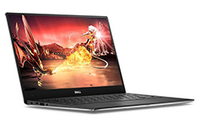Why you can trust TechRadar
Here’s how the HP Folio Spectre performed in our suite of benchmark tests:
Cinebench CPU: 279 points; Graphics: 43.08 fps
GeekBench: 4,966 (single-core); 8,785 (multi-core)
PCMark 8 (Home Test): 2,805 points
Battery Life (TechRadar movie test): 7 hours and 51 minutes
The HP Folio Spectre configuration we were sent for review comes with an 8th generation Intel Core i7-8500Y processor, 256Gb SSD and 8GB of RAM, all of which make Windows 10 feel fast and responsive during day-to-day tasks.
While it should go without saying that a laptop of this price can run Windows 10 without an issue, that’s unfortunately not always the case with some laptops. However, for the most part, the HP Folio Spectre does a very good job, though we found that unzipping files on the device took a while.
The Intel i7-8500Y processor is an 8th generation chip from Intel with two cores and base frequency of 1.50GHz and a turbo frequency of 4.20GHz. So, it’s not the fastest processor, or the most adept at multi-tasking, but it has an impressively low TDP of 5W.
This allows for a fanless design that keeps the HP Folio Spectre impressively thin, while being almost entirely silent when in use. It also means battery life is prolonged – more on that in a moment.

In our benchmarks, the HP Folio Spectre lagged behind rivals such as the Dell XPS 13 and Huawei MateBook X Pro, both of which come with quad-core Core i7 processors, which does make a difference when it comes to performance.
The screen is bright and vibrant, and watching media on it is a joy. The speakers are by Bang & Olufsen, but unfortunately they don’t quite match the quality of the screen. There’s very little bass to them, which leaves sounds, especially music and action scenes in films, feeling a little flat. It’s a shame.
Graphics are handled by the integrated Intel UHD Graphics 615 GPU. It does the job of displaying Windows 10, apps and media at 1080p, but don’t expect to play any graphically-challenging games on this thing, or edit videos. For most people, however, that won’t be a concern.
However, as we mentioned, in day-to-day use the Folio Spectre performed well, as long as you don’t try any more intensive tasks, such as video encoding and editing. The silent, fanless design, and long battery life make a compelling case for HP’s choice of components here, balancing performance with design elegance and battery life.

Battery life
Another area where the HP Folio Spectre can legitimately claim to be revolutionary is in its battery life, with HP promising up to 18 hours on a single charge. This is seriously impressive for an Intel-powered laptop, almost reaching the giddy heights achieved by lower-powered ARM laptops, like the HP Envy x2.
By offering better performance with not much impact on battery life, the HP Folio Spectre offers a very tempting alternative, and if you’re looking for a laptop that grants you almost a full day’s worth of battery life, while not being hamstrung by poor performance, then the high cost of the Folio Spectre may be justified.
However, although HP promises 18 hours, what is the battery life really like? Well, although the HP Folio Spectre did a good job, lasting 7 hours and 51 minutes in our battery benchmark, where we run a looped 1080p video at 50% brightness, it was still far off the 18 hours promised.
Of course, with a bit of tweaking, such as dimming the screen more, turning off Wi-Fi and changing the power settings, you may see a longer battery life, but also bear in mind that for web browsing, media streaming and other tasks, the battery may drain more quickly.
Still, almost eight hours is still a very decent amount of time, and means you should be able to go a full workday without needing a charge.

Final verdict
When the HP Folio Spectre was first unveiled, we have to admit we were a little underwhelmed. This was due to HP over hyping the reveal in the run up, promising a laptop that would reinvent the market. However, during our time with the HP Folio Spectre, we’ve come to really like it, and while it’s not the revolutionary 2-in-1 we were promised, it’s a very nicely put together device.
The design is simply stunning, and during our tests a number of people approached us to ask about the laptop, as it really does look gorgeous and stand out from the crowd. Most people’s excitement was quickly tempered, however, when we revealed the price. At $1,499 (£1,499, around £2,600), this is a very expensive laptop that will be out of the price range of many people.
If you can afford it, however, you’ll be very pleased. The design and build quality exude a premium feel, and the screen looks brilliant as well. The inclusion of a stylus is also welcome. Putting the HP Folio Spectre into its various modes is easy, with the solid construction ensuring that the Folio remains feeling sturdy.
However, it’s not the most powerful laptop at this price, and the speakers let it down in the media playing department. If you’re after a solid and dependable work laptop that is incredibly stylish and will elicit impressed murmurs in the boardroom, then you’ll love the HP Folio Spectre.
If power is more important than style, however, then your money would be better off spent elsewhere, with the Matebook X Pro and Dell XPS 13 (or XPS 15) worth considering instead.
Need a better alternative?
15 best laptops available to buy today
TechRadar has reviewed hundreds of laptops so that we're able to offer you the authoritative buying advice you expect. Whatever you're looking for in a laptop, we've rounded up all the best options in our helpful buying guide so you can decide whether the HP Spectre Folio really is the best option for you.
10 best 2-in-1 laptops in the world today
The Chromebook Pixel is one of the best 2-in-1 laptops out there but if you want to see the other best options, take a look at our round-up of the best 2-in-1 laptops available today.

Matt is TechRadar's Managing Editor for Core Tech, looking after computing and mobile technology. Having written for a number of publications such as PC Plus, PC Format, T3 and Linux Format, there's no aspect of technology that Matt isn't passionate about, especially computing and PC gaming. He’s personally reviewed and used most of the laptops in our best laptops guide - and since joining TechRadar in 2014, he's reviewed over 250 laptops and computing accessories personally.


